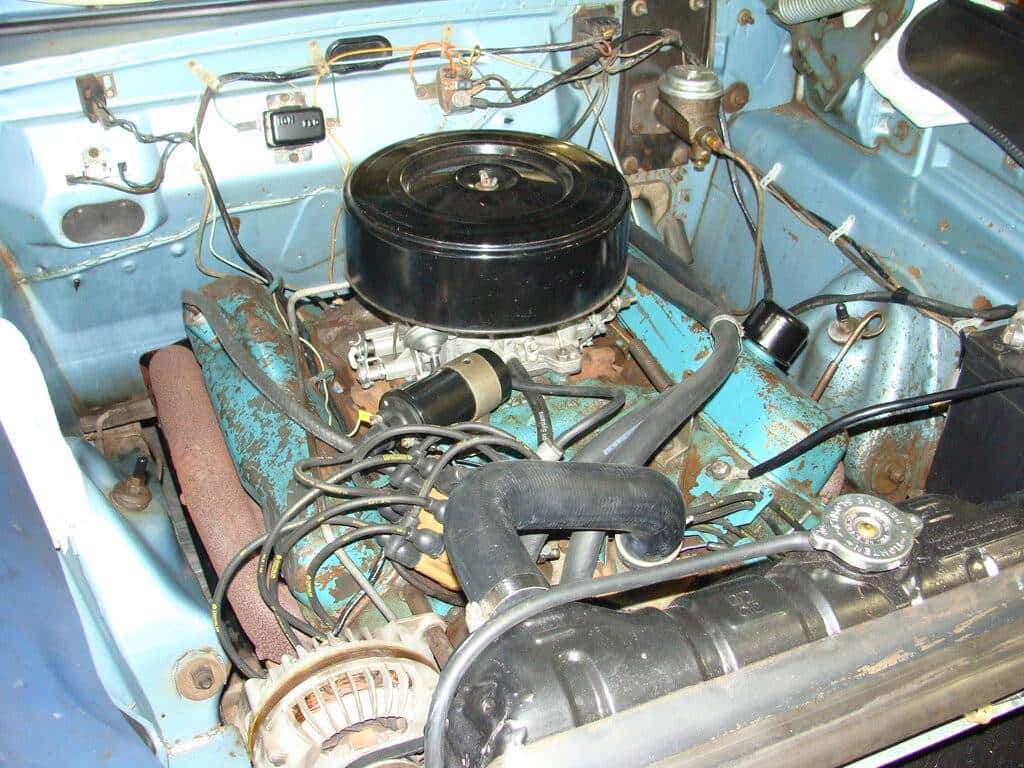The Dodge 440, a legendary big-block V8 engine introduced by Chrysler in 1965, powered a range of iconic vehicles, including muscle cars like the Dodge Coronet and Charger, as well as trucks and motorhomes.
For the Dodge 440, use high-ZDDP oils, such as Valvoline VR-1 10W-30 or 20W-50, or Royal Purple 10W-40 synthetic oil. Choose a viscosity based on your climate; pair it with a quality filter like Wix.
This article examines the optimal oil types for the Dodge 440, taking into account viscosity, additives, and regional factors, while drawing insights from online discussions and expert recommendations.
Understanding the Dodge 440 Engine
The Dodge 440, part of Chrysler’s RB (Raised Block) engine family, is a 7.2-liter V8 known for its high torque and horsepower, with variants like the 440 Six Pack producing up to 390 horsepower in the early 1970s.
Its design, featuring a wedge-shaped combustion chamber, made it a versatile and powerful engine for both street and performance applications.

However, the flat-tappet camshaft, standard in engines of this era, requires oils with high levels of zinc and phosphorus (ZDDP) to reduce wear on critical components, such as the camshaft and lifters.
Modern oils, formulated for newer engines with roller camshafts, often lack sufficient ZDDP, making oil selection critical for the 440.
Recommended Oil Types and Viscosities
Choosing the right oil for a Dodge 440 depends on several factors, including engine condition, climate, and usage (street, racing, or occasional driving).
Based on insights from Mopar enthusiast forums and expert advice, the following oil types and viscosities are commonly recommended:
1. High-ZDDP Oils
Older engines, such as the 440, require oils with high zinc and phosphorus content (ZDDP) to protect flat-tappet camshafts. ZDDP forms a protective layer on metal surfaces, reducing wear during high-pressure contact. Popular high-ZDDP oils include:
- Valvoline VR-1 Racing Oil: Available in 10W-30 and 20W-50, VR-1 is a favorite due to its high ZDDP content (approximately 1,400 ppm) and affordability. The 10W-30 is ideal for colder climates or engines with tighter clearances, while 20W-50 suits high-temperature regions or performance builds.
- Amsoil Z-Rod: A synthetic oil in 10W-40 or 20W-50, explicitly designed for classic engines with flat-tappet cams, offering excellent ZDDP levels and long-term protection.
- Lucas Hot Rod & Classic Car Oil: Available in 10W-30 and 10W-40, this oil is formulated for vintage engines and includes ZDDP additives.
- Brad Penn (PennGrade 1): A semi-synthetic oil with high ZDDP, often recommended in 10W-40 or 20W-50 for performance applications.
2. Conventional vs. Synthetic
While conventional oils like Valvoline VR-1 are widely used due to their compatibility with older engines, synthetic options like Amsoil Z-Rod or Royal Purple (10W-40) offer superior thermal stability and flow characteristics.
However, some enthusiasts caution against using synthetic blends in older engines due to the potential for seal leaks, especially in high-mileage or unmodified engines. Conventional oils with ZDDP additives are often a safer choice for stock or lightly modified 440s.
3. Viscosity Recommendations
- 10W-30: Preferred for colder climates or engines with standard clearances, offering better flow at startup and sufficient protection for street-driven vehicles. Suitable for northern regions or winter driving.
- 10W-40: A versatile choice for moderate to warm climates, balancing cold-start flow with high-temperature stability. Commonly used in central and southern U.S. regions.
- 20W-50: Best for high-performance builds, racing, or hot climates (e.g., Southern states), where thicker oil provides better protection under high heat and load. Not recommended for cold weather due to slower startup flow.
- Straight 30W or 40W: Some owners, particularly in warm climates like Oklahoma, use straight-weight oils for high-performance or heavily modified 440s; however, these are less common due to the limited cold-weather performance.
4. Diesel Oils
Diesel oils, such as Shell Rotella T or Chevron Delo, were historically recommended for their high ZDDP content.
However, modern formulations have reduced ZDDP to meet emission standards for diesel engines with particulate filters. Enthusiasts suggest checking current ZDDP levels before using diesel oils, as older formulations were more suitable.
Oil Capacity Considerations
The oil capacity of a Dodge 440 varies depending on the oil pan and application (car, truck, or motorhome). Common capacities include:
- Cars: Most stock 440s in cars (e.g., 1969 Coronet R/T) utilize a 5-quart pan, plus an additional 1 quart for the filter, totaling 6 quarts. Some high-performance models, such as the 440 Six Pack, may require 6 quarts in the pan, plus 1 quart for the filter (7 quarts total).
- Trucks and Motorhomes: Industrial 440s, often found in trucks or RVs, may have larger pans that hold 7 to 9 quarts, depending on the pan design (e.g., front or dual drain plugs). Always verify the pan type and dipstick accuracy, as aftermarket or mismatched dipsticks can lead to incorrect readings.
To ensure proper oil levels, check the dipstick after adding the recommended amount and running the engine briefly. Overfilling can cause seal damage, while underfilling risks oil starvation.
Additional Considerations
- ZDDP Additives: If using a standard oil with low ZDDP content, additives like STP or Lucas can help boost zinc and phosphorus levels. However, high-ZDDP oils, such as Valvoline VR-1 or Amsoil Z-Rod, often eliminate the need for additives.
- Oil Filters: Avoid low-quality filters, such as Fram, which may collapse under high-pressure conditions in performance builds. Wix or Napa Gold filters are recommended for their reliability.
- Change Intervals: For street-driven 440s, change the oil every 2,500–3,000 miles to prevent sludge buildup, especially in engines with high blow-by or stop-and-go driving conditions.
- Climate and Usage: In colder climates (e.g., Michigan), 10W-30 or 5W-30 improves cold-start flow. In warmer climates (e.g., Florida), 10W-40 or 20W-50 is better for heat resistance. Performance engines under heavy load may benefit from thicker oils, such as 20W-50.
What oil is best for a 440bb?
For your 440 big block, I recommend using Valvoline VR-1 10W-30 or 20W-50, which features high zinc to protect the engine. Use 10W-30 in cooler weather and 20W-50 in hot climates. Always use a Wix filter.
Which is the best oil? 10w30 or 10w40?
For a Dodge 440, 10W-30 is ideal for cold weather, as it flows easily at startup. 10W-40 works better in warmer climates, offering more heat protection. Choose Valvoline VR-1 or Amsoil Z-Rod, which contain high zinc.
Good oil to use in my ’68 440?
For your 1968 Dodge 440, consider using Valvoline VR-1 10W-30 or Royal Purple 10W-40, which features high zinc content to protect the flat-tappet cam. Use 10W-30 in cooler areas and pair it with a Wix filter for added reliability.
What oil would you use on this 440 engine?
I’d use Valvoline VR-1 10W-30 for cooler climates or 20W-50 for hot ones on a Dodge 440. Both have high zinc for cam protection. Pair with a Napa Gold or Wix filter for best results.
Motor oil for 1970 440 Charger R/T
For your 1970 Charger R/T 440, opt for Valvoline VR-1 10W-30 or Amsoil Z-Rod 10W-40, which is high in zinc. Use 6-7 quarts with a Wix filter. Change every 3,000 miles to keep it running great.
Dodge 440 oil type and capacity
Use Valvoline VR-1 10W-30 or 20W-50 for a Dodge 440, with high zinc for cam protection. Capacity is 6-7 quarts (5-quart pan + 1-quart filter). Use 10W-30 oil for cold weather, with a Wix filter.
1970 Dodge Charger 440 oil capacity
A 1970 Dodge Charger 440 typically needs 6-7 quarts of oil (5-quart pan + 1-quart filter). Use high-zinc Valvoline VR-1 10W-30 or 20W-50. Check the dipstick and use a Wix filter for reliability.
Mopar 400 big block oil capacity
The Mopar 400 big block (similar to the 440) uses about 6-7 quarts (5-quart pan + 1-quart filter). Try Valvoline VR-1 10W-30, featuring high zinc for enhanced protection. Always use a Wix or Napa Gold filter.
FAQs
What kind of oil does a 1970 Dodge Charger take?
For a 1970 Dodge Charger with a 440 engine, use Valvoline VR-1 10W-30 or 20W-50 with high zinc content. Pair with a Wix filter.
What oil does Mopar recommend?
Mopar fans recommend Valvoline VR-1 10W-30 or Amsoil Z-Rod 10W-40, which is high-zinc for 440 engines. Use a Wix filter.
How much oil does a 73 440 take?
A 1973 Dodge 440 needs 6-7 quarts (5-quart pan + 1-quart filter). Use Valvoline VR-1 10W-30 with a Wix filter.
What kind of oil does a 1969 Dodge Charger take?
For a 1969 Charger 440, go with Valvoline VR-1 10W-30 or 20W-50 for high zinc. Use a reliable Wix filter.
Which engine oil is best for a Dodge Charger?
Valvoline VR-1 10W-30 or Royal Purple 10W-40 with high zinc is best for a Dodge Charger 440. Use the Wix filter.
Conclusion
Selecting the right oil for a Dodge 440 involves balancing viscosity, ZDDP content, and the engine’s operating conditions. High-ZDDP oils, such as Valvoline VR-1 (10W-30 or 20W-50), Amsoil Z-Rod, or Lucas Hot Rod Oil, are top choices for protecting flat-tappet camshafts. The 10W-30 or 10W-40 formulations are versatile for most climates and street use. Always verify oil capacity based on the pan type and ensure regular maintenance to keep the 440 running strong. By selecting a high-quality oil and filter and adjusting the viscosity to suit your region and driving style, you can optimize the performance and longevity of this iconic Mopar engine.

